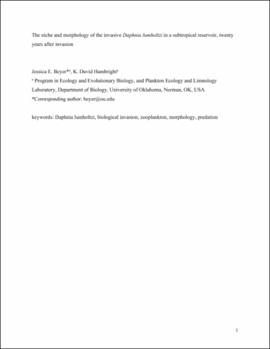| dc.contributor.advisor | | |
| dc.contributor.author | Beyer, Jessica E. | |
| dc.contributor.author | Hambright, K. David | |
| dc.date.accessioned | 2020-10-29T21:06:46Z | |
| dc.date.available | 2020-10-29T21:06:46Z | |
| dc.date.issued | 2019-01-11 | |
| dc.identifier.citation | Beyer, J. E., and K. D. Hambright. (2019) The niche and morphology of the invasive Daphnia lumholtzi in a subtropical reservoir, 20 years after invasion. Journal of Plankton Research 41(2): 90-100. https://doi-org.ezproxy.lib.ou.edu/10.1093/plankt/fby053 | en_US |
| dc.identifier.uri | https://hdl.handle.net/11244/325642 | |
| dc.description.abstract | The establishment and persistence of invasive species are continuously shaped by resource availability, competition and predation, yet most research is conducted immediately after invasion. Twenty years after Daphnia lumholtzi invaded Lake Texoma, OK-TX we uncovered seasonality in D. lumholtzi abundances and defensive morphology. Tail-spine growth was hyperallometric (faster than core body growth) in summer and fall, but allometric (growing at same rate as body) in winter. Head-spine growth declined with increasing body size, and was curvilinear in summer and fall, but linear in winter. Thus, we hypothesized that the selective predation pressure acting upon these traits is strongest in summer and fall and that the large plastic defensive spines allow persistence of D. lumholtzi. Additionally, we found that abundances of D. lumholtzi in Lake Texoma were best predicted by cyanobacteria concentration. However, as lab experiments have shown that D. lumholtzi does not have superior cyanobacteria tolerance, cyanobacteria may be serving as a proxy for another pressure shaping the abundance of D. lumholtzi, like a seasonal predator. The niche of this invasive species within Lake Texoma appears to be primarily limited by predation pressure, and further studies may illuminate whether this limiting factor is responsible for range limits within North America. | en_US |
| dc.description.sponsorship | Funding was provided by the Oklahoma Department of Wildlife Conservation (through the Sport Fish Restoration Program, Grant F-61-R to K.D.H), the University of Oklahoma Biological Station (through a Graduate Research Fellowship to J.E.B) and the University of Oklahoma Department of Biology (through an Adams Fellowship to J.E.B). | |
| dc.language | en_US | en_US |
| dc.subject | Daphnia lumholtzi | en_US |
| dc.subject | Biological invasion | en_US |
| dc.subject | Zooplankton | en_US |
| dc.subject | Morphology | en_US |
| dc.subject | Predation | en_US |
| dc.title | The niche and morphology of the invasive Daphnia lumholtzi in a subtropical reservoir, 20 years after invasion | en_US |
| dc.type | Article | en_US |
| dc.description.peerreview | Yes | en_US |
| dc.identifier.doi | 10.1093/plankt/fby053 | en_US |
| ou.group | College of Arts and Sciences::Department of Biology | en_US |
